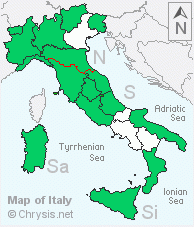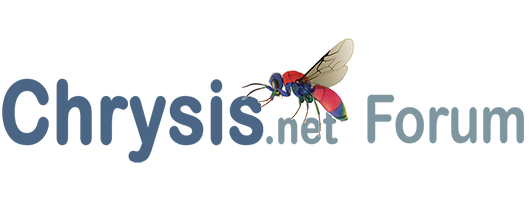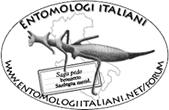| Scientific name |
Country |
Locality |
State province |
Coordinates |
Month & Year |
Basis of record |
Dataset |
Recorded by |
Collection code |
Institution code |
Identified by |
| BOLD:AEU5027 |
Spain |
Segovia, Carbonero el Mayor, 500 m W, Calle las Tejeras |
Castilla y Leon |
|
7 2021 |
MATERIAL_SAMPLE |
|
Thomas Wood |
|
|
Paolo Rosa |
| BOLD:AEU5027 |
Portugal |
Cabanas, near Tavira |
Faro |
|
5 2016 |
MATERIAL_SAMPLE |
|
Thomas Wood |
|
|
Paolo Rosa |
| BOLD:AEU5027 |
Portugal |
Cabanas, near Tavira |
Faro |
|
5 2016 |
MATERIAL_SAMPLE |
|
Thomas Wood |
|
|
Paolo Rosa |
| Omalus punctulatus Dahlbom, 1854 |
Japan |
|
Tochigi |
|
8 2008 |
PRESERVED_SPECIMEN |
|
|
I |
NASU |
|
| Omalus punctulatus Dahlbom, 1854 |
Japan |
|
Tochigi |
|
8 2008 |
PRESERVED_SPECIMEN |
|
|
I |
NASU |
|
| Omalus punctulatus Dahlbom, 1854 |
Japan |
|
Hyogo |
|
9 1993 |
PRESERVED_SPECIMEN |
|
|
B |
MNHAH |
|
| Omalus punctulatus Dahlbom, 1854 |
Japan |
HYOGO |
Hyogo |
|
9 1993 |
PRESERVED_SPECIMEN |
|
Naoto Sugiura |
ENT |
HYO |
|
| Omalus punctulatus Dahlbom, 1854 |
Morocco |
Atlas Ifrane |
|
|
6 1988 |
MATERIAL_CITATION |
|
Linsenmaier |
|
NML_ENT |
|
| Omalus punctulatus Dahlbom, 1854 |
Morocco |
Hoher Atlas Tichka-Pass-Sud |
|
|
7 1975 |
MATERIAL_CITATION |
|
A. W. Ebmer |
|
NML_ENT |
|
| Omalus punctulatus Dahlbom, 1854 |
Japan |
|
Shizuoka |
|
5 1974 |
PRESERVED_SPECIMEN |
|
|
Hy |
OMNH |
|
| Omalus punctulatus Dahlbom, 1854 |
Japan |
|
Shizuoka |
|
5 1974 |
PRESERVED_SPECIMEN |
|
|
Hy |
OMNH |
|
| Omalus punctulatus Dahlbom, 1854 |
Japan |
|
Fukui |
|
9 1973 |
PRESERVED_SPECIMEN |
|
|
Hy |
OMNH |
|
| Omalus punctulatus Dahlbom, 1854 |
Japan |
|
Fukui |
|
9 1973 |
PRESERVED_SPECIMEN |
|
|
Hy |
OMNH |
|
| Omalus punctulatus Dahlbom, 1854 |
Japan |
|
Fukui |
|
9 1973 |
PRESERVED_SPECIMEN |
|
|
Hy |
OMNH |
|
| Omalus punctulatus Dahlbom, 1854 |
Japan |
|
Fukui |
|
10 1973 |
PRESERVED_SPECIMEN |
|
|
Hy |
OMNH |
|
| Omalus punctulatus Dahlbom, 1854 |
Japan |
|
Fukui |
|
5 1972 |
PRESERVED_SPECIMEN |
|
|
Hy |
OMNH |
|
| Omalus punctulatus Dahlbom, 1854 |
Japan |
|
Fukui |
|
5 1972 |
PRESERVED_SPECIMEN |
|
|
Hy |
OMNH |
|
| Omalus punctulatus Dahlbom, 1854 |
Japan |
|
Fukui |
|
9 1972 |
PRESERVED_SPECIMEN |
|
|
Hy |
OMNH |
|
| Omalus punctulatus Dahlbom, 1854 |
Japan |
|
Fukui |
|
9 1972 |
PRESERVED_SPECIMEN |
|
|
Hy |
OMNH |
|
| Omalus punctulatus Dahlbom, 1854 |
Japan |
|
Fukui |
|
8 1970 |
PRESERVED_SPECIMEN |
|
|
Hy |
OMNH |
|
| Omalus punctulatus Dahlbom, 1854 |
Japan |
|
Fukui |
|
5 1969 |
PRESERVED_SPECIMEN |
|
|
Hy |
OMNH |
|
| Omalus punctulatus Dahlbom, 1854 |
Japan |
|
Fukui |
|
5 1969 |
PRESERVED_SPECIMEN |
|
|
Hy |
OMNH |
|
| Omalus punctulatus Dahlbom, 1854 |
Japan |
|
Fukui |
|
5 1969 |
PRESERVED_SPECIMEN |
|
|
Hy |
OMNH |
|
| Omalus punctulatus Dahlbom, 1854 |
Japan |
|
Fukui |
|
5 1969 |
PRESERVED_SPECIMEN |
|
|
Hy |
OMNH |
|
| Omalus punctulatus Dahlbom, 1854 |
Japan |
|
Fukui |
|
5 1969 |
PRESERVED_SPECIMEN |
|
|
Hy |
OMNH |
|
| Omalus punctulatus Dahlbom, 1854 |
Japan |
|
Fukui |
|
5 1969 |
PRESERVED_SPECIMEN |
|
|
Hy |
OMNH |
|
| Omalus punctulatus Dahlbom, 1854 |
Japan |
|
Fukui |
|
8 1969 |
PRESERVED_SPECIMEN |
|
|
Hy |
OMNH |
|
| Omalus punctulatus Dahlbom, 1854 |
Japan |
|
Fukui |
|
9 1969 |
PRESERVED_SPECIMEN |
|
|
Hy |
OMNH |
|
| Omalus punctulatus Dahlbom, 1854 |
Japan |
|
Fukui |
|
7 1967 |
PRESERVED_SPECIMEN |
|
|
Hy |
OMNH |
|
| Omalus punctulatus Dahlbom, 1854 |
Japan |
|
Fukui |
|
7 1967 |
PRESERVED_SPECIMEN |
|
|
Hy |
OMNH |
|
| Omalus punctulatus Dahlbom, 1854 |
Japan |
|
Hokkaido |
|
8 1966 |
PRESERVED_SPECIMEN |
|
|
Hy |
OMNH |
|
| Omalus punctulatus Dahlbom, 1854 |
Japan |
|
Fukui |
|
8 1965 |
PRESERVED_SPECIMEN |
|
|
Hy |
OMNH |
|
| Omalus punctulatus Dahlbom, 1854 |
Japan |
|
Fukui |
|
9 1964 |
PRESERVED_SPECIMEN |
|
|
Hy |
OMNH |
|
| Omalus punctulatus Dahlbom, 1854 |
Morocco |
Atlas Imouzzer |
|
|
7 1963 |
MATERIAL_CITATION |
|
Linsenmaier |
|
NML_ENT |
|
| Omalus punctulatus Dahlbom, 1854 |
Japan |
|
Fukui |
|
8 1963 |
PRESERVED_SPECIMEN |
|
|
Hy |
OMNH |
|
| Omalus punctulatus Dahlbom, 1854 |
Japan |
|
Fukui |
|
5 1962 |
PRESERVED_SPECIMEN |
|
|
Hy |
OMNH |
|
| Omalus punctulatus Dahlbom, 1854 |
Japan |
|
Ishikawa |
|
8 1962 |
PRESERVED_SPECIMEN |
|
|
Hy |
OMNH |
|
| Omalus punctulatus Dahlbom, 1854 |
Japan |
|
Ishikawa |
|
9 1962 |
PRESERVED_SPECIMEN |
|
|
Hy |
OMNH |
|
| Omalus punctulatus Dahlbom, 1854 |
Japan |
|
Ishikawa |
|
8 1961 |
PRESERVED_SPECIMEN |
|
|
Hy |
OMNH |
|
| Omalus punctulatus Dahlbom, 1854 |
Japan |
|
Niigata |
|
8 1959 |
PRESERVED_SPECIMEN |
|
|
Hy |
OMNH |
|
| Omalus punctulatus Dahlbom, 1854 |
Japan |
|
Osaka |
|
9 1959 |
PRESERVED_SPECIMEN |
|
|
Hy |
OMNH |
|
| Omalus punctulatus Dahlbom, 1854 |
Japan |
|
Hokkaido |
|
8 1958 |
PRESERVED_SPECIMEN |
|
|
Hy |
OMNH |
|
| Omalus punctulatus Dahlbom, 1854 |
Japan |
|
Hokkaido |
|
8 1958 |
PRESERVED_SPECIMEN |
|
|
Hy |
OMNH |
|
| Omalus punctulatus Dahlbom, 1854 |
Japan |
|
Hokkaido |
|
8 1958 |
PRESERVED_SPECIMEN |
|
|
Hy |
OMNH |
|
| Omalus punctulatus Dahlbom, 1854 |
Japan |
|
Hokkaido |
|
8 1958 |
PRESERVED_SPECIMEN |
|
|
Hy |
OMNH |
|
| Omalus punctulatus Dahlbom, 1854 |
Japan |
|
Fukui |
|
5 1956 |
PRESERVED_SPECIMEN |
|
|
Hy |
OMNH |
|
| Omalus punctulatus Dahlbom, 1854 |
Japan |
|
Fukui |
|
6 1956 |
PRESERVED_SPECIMEN |
|
|
Hy |
OMNH |
|
| Omalus punctulatus Dahlbom, 1854 |
Japan |
|
Fukui |
|
6 1956 |
PRESERVED_SPECIMEN |
|
|
Hy |
OMNH |
|
| Omalus punctulatus Dahlbom, 1854 |
Japan |
|
Fukui |
|
6 1956 |
PRESERVED_SPECIMEN |
|
|
Hy |
OMNH |
|
| Omalus punctulatus Dahlbom, 1854 |
Japan |
|
Fukui |
|
6 1956 |
PRESERVED_SPECIMEN |
|
|
Hy |
OMNH |
|
| Omalus punctulatus Dahlbom, 1854 |
Japan |
|
Fukui |
|
6 1956 |
PRESERVED_SPECIMEN |
|
|
Hy |
OMNH |
|
| Omalus punctulatus Dahlbom, 1854 |
Japan |
|
Fukui |
|
6 1956 |
PRESERVED_SPECIMEN |
|
|
Hy |
OMNH |
|
| Omalus punctulatus Dahlbom, 1854 |
Japan |
|
Ishikawa |
|
7 1956 |
PRESERVED_SPECIMEN |
|
|
Hy |
OMNH |
|
| Omalus punctulatus Dahlbom, 1854 |
Japan |
|
Fukui |
|
5 1955 |
PRESERVED_SPECIMEN |
|
|
Hy |
OMNH |
|
| Omalus punctulatus Dahlbom, 1854 |
Japan |
|
Fukui |
|
5 1955 |
PRESERVED_SPECIMEN |
|
|
Hy |
OMNH |
|
| Omalus punctulatus Dahlbom, 1854 |
Japan |
|
Fukui |
|
5 1955 |
PRESERVED_SPECIMEN |
|
|
Hy |
OMNH |
|
| Omalus punctulatus Dahlbom, 1854 |
Japan |
|
Fukui |
|
5 1955 |
PRESERVED_SPECIMEN |
|
|
Hy |
OMNH |
|
| Omalus punctulatus Dahlbom, 1854 |
Japan |
|
Fukui |
|
5 1955 |
PRESERVED_SPECIMEN |
|
|
Hy |
OMNH |
|
| Omalus punctulatus Dahlbom, 1854 |
Japan |
|
Fukui |
|
5 1955 |
PRESERVED_SPECIMEN |
|
|
Hy |
OMNH |
|
| Omalus punctulatus Dahlbom, 1854 |
Japan |
|
Fukui |
|
5 1955 |
PRESERVED_SPECIMEN |
|
|
Hy |
OMNH |
|
| Omalus punctulatus Dahlbom, 1854 |
Japan |
|
Fukui |
|
5 1955 |
PRESERVED_SPECIMEN |
|
|
Hy |
OMNH |
|
| Omalus punctulatus Dahlbom, 1854 |
Japan |
|
Fukui |
|
6 1955 |
PRESERVED_SPECIMEN |
|
|
Hy |
OMNH |
|
| Omalus punctulatus Dahlbom, 1854 |
Japan |
|
Fukui |
|
6 1955 |
PRESERVED_SPECIMEN |
|
|
Hy |
OMNH |
|
| Omalus punctulatus Dahlbom, 1854 |
Japan |
|
Fukui |
|
6 1955 |
PRESERVED_SPECIMEN |
|
|
Hy |
OMNH |
|
| Omalus punctulatus Dahlbom, 1854 |
Japan |
|
Fukui |
|
6 1955 |
PRESERVED_SPECIMEN |
|
|
Hy |
OMNH |
|
| Omalus punctulatus Dahlbom, 1854 |
Japan |
|
Ishikawa |
|
7 1955 |
PRESERVED_SPECIMEN |
|
|
Hy |
OMNH |
|
| Omalus punctulatus Dahlbom, 1854 |
Japan |
|
Aomori |
|
8 1955 |
PRESERVED_SPECIMEN |
|
|
Hy |
OMNH |
|
| Omalus punctulatus Dahlbom, 1854 |
Japan |
|
Fukui |
|
5 1954 |
PRESERVED_SPECIMEN |
|
|
Hy |
OMNH |
|
| Omalus punctulatus Dahlbom, 1854 |
Japan |
|
Fukui |
|
5 1954 |
PRESERVED_SPECIMEN |
|
|
Hy |
OMNH |
|
| Omalus punctulatus Dahlbom, 1854 |
Japan |
|
Fukui |
|
5 1954 |
PRESERVED_SPECIMEN |
|
|
Hy |
OMNH |
|
| Omalus punctulatus Dahlbom, 1854 |
Japan |
|
Fukui |
|
5 1954 |
PRESERVED_SPECIMEN |
|
|
Hy |
OMNH |
|
| Omalus punctulatus Dahlbom, 1854 |
Japan |
|
Fukui |
|
6 1954 |
PRESERVED_SPECIMEN |
|
|
Hy |
OMNH |
|
| Omalus punctulatus Dahlbom, 1854 |
Japan |
|
Fukui |
|
6 1954 |
PRESERVED_SPECIMEN |
|
|
Hy |
OMNH |
|
| Omalus punctulatus Dahlbom, 1854 |
Japan |
|
Fukui |
|
6 1954 |
PRESERVED_SPECIMEN |
|
|
Hy |
OMNH |
|
| Omalus punctulatus Dahlbom, 1854 |
Japan |
|
Fukui |
|
6 1954 |
PRESERVED_SPECIMEN |
|
|
Hy |
OMNH |
|
| Omalus punctulatus Dahlbom, 1854 |
Japan |
|
Fukui |
|
6 1954 |
PRESERVED_SPECIMEN |
|
|
Hy |
OMNH |
|
| Omalus punctulatus Dahlbom, 1854 |
Japan |
|
Fukui |
|
6 1954 |
PRESERVED_SPECIMEN |
|
|
Hy |
OMNH |
|
| Omalus punctulatus Dahlbom, 1854 |
Japan |
|
Fukui |
|
6 1954 |
PRESERVED_SPECIMEN |
|
|
Hy |
OMNH |
|
| Omalus punctulatus Dahlbom, 1854 |
Japan |
|
Fukui |
|
6 1954 |
PRESERVED_SPECIMEN |
|
|
Hy |
OMNH |
|
| Omalus punctulatus Dahlbom, 1854 |
Japan |
|
Fukui |
|
6 1954 |
PRESERVED_SPECIMEN |
|
|
Hy |
OMNH |
|
| Omalus punctulatus Dahlbom, 1854 |
Japan |
|
Fukui |
|
6 1954 |
PRESERVED_SPECIMEN |
|
|
Hy |
OMNH |
|
| Omalus punctulatus Dahlbom, 1854 |
Japan |
|
Fukui |
|
6 1954 |
PRESERVED_SPECIMEN |
|
|
Hy |
OMNH |
|
| Omalus punctulatus Dahlbom, 1854 |
Japan |
|
Fukui |
|
6 1954 |
PRESERVED_SPECIMEN |
|
|
Hy |
OMNH |
|
| Omalus punctulatus Dahlbom, 1854 |
Japan |
|
Ishikawa |
|
7 1954 |
PRESERVED_SPECIMEN |
|
|
Hy |
OMNH |
|
| Omalus punctulatus Dahlbom, 1854 |
Japan |
|
Fukui |
|
5 1953 |
PRESERVED_SPECIMEN |
|
|
Hy |
OMNH |
|
| Omalus punctulatus Dahlbom, 1854 |
Japan |
|
Fukui |
|
5 1953 |
PRESERVED_SPECIMEN |
|
|
Hy |
OMNH |
|
| Omalus punctulatus Dahlbom, 1854 |
Japan |
|
Fukui |
|
5 1953 |
PRESERVED_SPECIMEN |
|
|
Hy |
OMNH |
|
| Omalus punctulatus Dahlbom, 1854 |
Japan |
|
Ishikawa |
|
8 1953 |
PRESERVED_SPECIMEN |
|
|
Hy |
OMNH |
|
| Omalus punctulatus Dahlbom, 1854 |
Japan |
|
Hokkaido |
|
6 1952 |
PRESERVED_SPECIMEN |
|
|
Hy |
OMNH |
|
| Omalus punctulatus Dahlbom, 1854 |
Japan |
|
Hokkaido |
|
6 1952 |
PRESERVED_SPECIMEN |
|
|
Hy |
OMNH |
|
| Omalus punctulatus Dahlbom, 1854 |
Japan |
|
Hokkaido |
|
6 1952 |
PRESERVED_SPECIMEN |
|
|
Hy |
OMNH |
|
| Omalus punctulatus Dahlbom, 1854 |
Japan |
|
Hokkaido |
|
6 1952 |
PRESERVED_SPECIMEN |
|
|
Hy |
OMNH |
|
| Omalus punctulatus Dahlbom, 1854 |
Japan |
|
Hokkaido |
|
6 1952 |
PRESERVED_SPECIMEN |
|
|
Hy |
OMNH |
|
| Omalus punctulatus Dahlbom, 1854 |
Japan |
|
Hokkaido |
|
6 1952 |
PRESERVED_SPECIMEN |
|
|
Hy |
OMNH |
|
| Omalus punctulatus Dahlbom, 1854 |
Japan |
|
Hokkaido |
|
6 1952 |
PRESERVED_SPECIMEN |
|
|
Hy |
OMNH |
|
| Omalus punctulatus Dahlbom, 1854 |
Japan |
|
Hokkaido |
|
6 1952 |
PRESERVED_SPECIMEN |
|
|
Hy |
OMNH |
|
| Omalus punctulatus Dahlbom, 1854 |
Japan |
|
Hokkaido |
|
6 1952 |
PRESERVED_SPECIMEN |
|
|
Hy |
OMNH |
|
| Omalus punctulatus Dahlbom, 1854 |
Japan |
|
Hokkaido |
|
6 1952 |
PRESERVED_SPECIMEN |
|
|
Hy |
OMNH |
|
| Omalus punctulatus Dahlbom, 1854 |
Japan |
|
Hokkaido |
|
6 1952 |
PRESERVED_SPECIMEN |
|
|
Hy |
OMNH |
|
| Omalus punctulatus Dahlbom, 1854 |
Japan |
|
Hokkaido |
|
6 1952 |
PRESERVED_SPECIMEN |
|
|
Hy |
OMNH |
|
| Omalus punctulatus Dahlbom, 1854 |
Japan |
|
Hokkaido |
|
6 1952 |
PRESERVED_SPECIMEN |
|
|
Hy |
OMNH |
|
| Omalus punctulatus Dahlbom, 1854 |
Japan |
|
Hokkaido |
|
6 1952 |
PRESERVED_SPECIMEN |
|
|
Hy |
OMNH |
|
| Omalus punctulatus Dahlbom, 1854 |
Japan |
|
Hokkaido |
|
6 1952 |
PRESERVED_SPECIMEN |
|
|
Hy |
OMNH |
|
| Omalus punctulatus Dahlbom, 1854 |
Japan |
|
Hokkaido |
|
6 1952 |
PRESERVED_SPECIMEN |
|
|
Hy |
OMNH |
|
| Omalus punctulatus Dahlbom, 1854 |
Japan |
|
Hokkaido |
|
6 1952 |
PRESERVED_SPECIMEN |
|
|
Hy |
OMNH |
|
| Omalus punctulatus Dahlbom, 1854 |
Japan |
|
Hokkaido |
|
6 1952 |
PRESERVED_SPECIMEN |
|
|
Hy |
OMNH |
|
| Omalus punctulatus Dahlbom, 1854 |
Japan |
|
Hokkaido |
|
6 1952 |
PRESERVED_SPECIMEN |
|
|
Hy |
OMNH |
|
| Omalus punctulatus Dahlbom, 1854 |
Japan |
|
Hokkaido |
|
6 1952 |
PRESERVED_SPECIMEN |
|
|
Hy |
OMNH |
|
| Omalus punctulatus Dahlbom, 1854 |
Japan |
|
Hokkaido |
|
6 1952 |
PRESERVED_SPECIMEN |
|
|
Hy |
OMNH |
|
| Omalus punctulatus Dahlbom, 1854 |
Japan |
|
Hokkaido |
|
6 1952 |
PRESERVED_SPECIMEN |
|
|
Hy |
OMNH |
|
| Omalus punctulatus Dahlbom, 1854 |
Japan |
|
Hokkaido |
|
6 1952 |
PRESERVED_SPECIMEN |
|
|
Hy |
OMNH |
|
| Omalus punctulatus Dahlbom, 1854 |
Japan |
|
Hokkaido |
|
6 1952 |
PRESERVED_SPECIMEN |
|
|
Hy |
OMNH |
|
| Omalus punctulatus Dahlbom, 1854 |
Japan |
|
Hokkaido |
|
6 1952 |
PRESERVED_SPECIMEN |
|
|
Hy |
OMNH |
|
| Omalus punctulatus Dahlbom, 1854 |
Japan |
|
Tochigi |
|
7 1951 |
PRESERVED_SPECIMEN |
|
|
Hy |
OMNH |
|
| Omalus punctulatus Dahlbom, 1854 |
Japan |
|
Tochigi |
|
8 1950 |
PRESERVED_SPECIMEN |
|
|
Hy |
OMNH |
|
| Omalus punctulatus Dahlbom, 1854 |
Japan |
|
Kyoto |
|
7 1949 |
PRESERVED_SPECIMEN |
|
|
Hy |
OMNH |
|
| Omalus punctulatus Dahlbom, 1854 |
Japan |
|
Hokkaido |
|
6 1947 |
PRESERVED_SPECIMEN |
|
|
Hy |
OMNH |
|
| Omalus punctulatus Dahlbom, 1854 |
Japan |
|
Hokkaido |
|
6 1947 |
PRESERVED_SPECIMEN |
|
|
Hy |
OMNH |
|
| Omalus punctulatus Dahlbom, 1854 |
Japan |
|
Hokkaido |
|
8 1947 |
PRESERVED_SPECIMEN |
|
|
Hy |
OMNH |
|
| Omalus punctulatus Dahlbom, 1854 |
Japan |
|
Hokkaido |
|
9 1947 |
PRESERVED_SPECIMEN |
|
|
Hy |
OMNH |
|
| Omalus punctulatus Dahlbom, 1854 |
Japan |
|
Yamagata |
|
9 1947 |
PRESERVED_SPECIMEN |
|
|
Hy |
OMNH |
|
| Omalus punctulatus Dahlbom, 1854 |
Japan |
|
Hokkaido |
|
6 1946 |
PRESERVED_SPECIMEN |
|
|
Hy |
OMNH |
|
| Omalus punctulatus Dahlbom, 1854 |
Japan |
|
Hokkaido |
|
6 1946 |
PRESERVED_SPECIMEN |
|
|
Hy |
OMNH |
|
| Omalus punctulatus Dahlbom, 1854 |
Japan |
|
Hokkaido |
|
6 1946 |
PRESERVED_SPECIMEN |
|
|
Hy |
OMNH |
|
| Omalus punctulatus Dahlbom, 1854 |
Japan |
|
Hokkaido |
|
6 1946 |
PRESERVED_SPECIMEN |
|
|
Hy |
OMNH |
|
| Omalus punctulatus Dahlbom, 1854 |
Japan |
|
Hokkaido |
|
6 1946 |
PRESERVED_SPECIMEN |
|
|
Hy |
OMNH |
|
| Omalus punctulatus Dahlbom, 1854 |
Japan |
|
Hokkaido |
|
6 1946 |
PRESERVED_SPECIMEN |
|
|
Hy |
OMNH |
|
| Omalus punctulatus Dahlbom, 1854 |
Japan |
|
Hokkaido |
|
6 1946 |
PRESERVED_SPECIMEN |
|
|
Hy |
OMNH |
|
| Omalus punctulatus Dahlbom, 1854 |
Japan |
|
Hokkaido |
|
6 1946 |
PRESERVED_SPECIMEN |
|
|
Hy |
OMNH |
|
| Omalus punctulatus Dahlbom, 1854 |
Japan |
|
Hokkaido |
|
6 1946 |
PRESERVED_SPECIMEN |
|
|
Hy |
OMNH |
|
| Omalus punctulatus Dahlbom, 1854 |
Japan |
|
Hokkaido |
|
6 1946 |
PRESERVED_SPECIMEN |
|
|
Hy |
OMNH |
|
| Omalus punctulatus Dahlbom, 1854 |
Japan |
|
Hokkaido |
|
6 1946 |
PRESERVED_SPECIMEN |
|
|
Hy |
OMNH |
|
| Omalus punctulatus Dahlbom, 1854 |
Japan |
|
Hokkaido |
|
6 1946 |
PRESERVED_SPECIMEN |
|
|
Hy |
OMNH |
|
| Omalus punctulatus Dahlbom, 1854 |
Japan |
|
Hokkaido |
|
6 1946 |
PRESERVED_SPECIMEN |
|
|
Hy |
OMNH |
|
| Omalus punctulatus Dahlbom, 1854 |
Japan |
|
Hokkaido |
|
6 1946 |
PRESERVED_SPECIMEN |
|
|
Hy |
OMNH |
|
| Omalus punctulatus Dahlbom, 1854 |
Japan |
|
Hokkaido |
|
6 1946 |
PRESERVED_SPECIMEN |
|
|
Hy |
OMNH |
|
| Omalus punctulatus Dahlbom, 1854 |
Japan |
|
Hokkaido |
|
6 1946 |
PRESERVED_SPECIMEN |
|
|
Hy |
OMNH |
|
| Omalus punctulatus Dahlbom, 1854 |
Japan |
|
Hokkaido |
|
6 1946 |
PRESERVED_SPECIMEN |
|
|
Hy |
OMNH |
|
| Omalus punctulatus Dahlbom, 1854 |
Japan |
|
Hokkaido |
|
6 1946 |
PRESERVED_SPECIMEN |
|
|
Hy |
OMNH |
|
| Omalus punctulatus Dahlbom, 1854 |
Japan |
|
Hokkaido |
|
6 1946 |
PRESERVED_SPECIMEN |
|
|
Hy |
OMNH |
|
| Omalus punctulatus Dahlbom, 1854 |
Japan |
|
Hokkaido |
|
6 1946 |
PRESERVED_SPECIMEN |
|
|
Hy |
OMNH |
|
| Omalus punctulatus Dahlbom, 1854 |
Japan |
|
Hokkaido |
|
6 1946 |
PRESERVED_SPECIMEN |
|
|
Hy |
OMNH |
|
| Omalus punctulatus Dahlbom, 1854 |
Japan |
|
Hokkaido |
|
6 1946 |
PRESERVED_SPECIMEN |
|
|
Hy |
OMNH |
|
| Omalus punctulatus Dahlbom, 1854 |
Japan |
|
Hokkaido |
|
6 1946 |
PRESERVED_SPECIMEN |
|
|
Hy |
OMNH |
|
| Omalus punctulatus Dahlbom, 1854 |
Japan |
|
Hokkaido |
|
6 1946 |
PRESERVED_SPECIMEN |
|
|
Hy |
OMNH |
|
| Omalus punctulatus Dahlbom, 1854 |
Japan |
|
Hokkaido |
|
6 1946 |
PRESERVED_SPECIMEN |
|
|
Hy |
OMNH |
|
| Omalus punctulatus Dahlbom, 1854 |
Japan |
|
Hokkaido |
|
6 1946 |
PRESERVED_SPECIMEN |
|
|
Hy |
OMNH |
|
| Omalus punctulatus Dahlbom, 1854 |
Japan |
|
Hokkaido |
|
6 1946 |
PRESERVED_SPECIMEN |
|
|
Hy |
OMNH |
|
| Omalus punctulatus Dahlbom, 1854 |
Japan |
|
Hokkaido |
|
6 1946 |
PRESERVED_SPECIMEN |
|
|
Hy |
OMNH |
|
| Omalus punctulatus Dahlbom, 1854 |
Japan |
|
Hokkaido |
|
6 1946 |
PRESERVED_SPECIMEN |
|
|
Hy |
OMNH |
|
| Omalus punctulatus Dahlbom, 1854 |
Japan |
|
Hokkaido |
|
6 1946 |
PRESERVED_SPECIMEN |
|
|
Hy |
OMNH |
|
| Omalus punctulatus Dahlbom, 1854 |
Japan |
|
Hokkaido |
|
6 1946 |
PRESERVED_SPECIMEN |
|
|
Hy |
OMNH |
|
| Omalus punctulatus Dahlbom, 1854 |
Japan |
|
Hokkaido |
|
6 1946 |
PRESERVED_SPECIMEN |
|
|
Hy |
OMNH |
|
| Omalus punctulatus Dahlbom, 1854 |
Japan |
|
Hokkaido |
|
6 1946 |
PRESERVED_SPECIMEN |
|
|
Hy |
OMNH |
|
| Omalus punctulatus Dahlbom, 1854 |
Japan |
|
Hokkaido |
|
6 1946 |
PRESERVED_SPECIMEN |
|
|
Hy |
OMNH |
|
| Omalus punctulatus Dahlbom, 1854 |
Japan |
|
Hokkaido |
|
6 1946 |
PRESERVED_SPECIMEN |
|
|
Hy |
OMNH |
|
| Omalus punctulatus Dahlbom, 1854 |
Japan |
|
Hokkaido |
|
6 1946 |
PRESERVED_SPECIMEN |
|
|
Hy |
OMNH |
|
| Omalus punctulatus Dahlbom, 1854 |
Japan |
|
Hokkaido |
|
6 1946 |
PRESERVED_SPECIMEN |
|
|
Hy |
OMNH |
|
| Omalus punctulatus Dahlbom, 1854 |
Japan |
|
Hokkaido |
|
6 1946 |
PRESERVED_SPECIMEN |
|
|
Hy |
OMNH |
|
| Omalus punctulatus Dahlbom, 1854 |
Japan |
|
Hokkaido |
|
6 1946 |
PRESERVED_SPECIMEN |
|
|
Hy |
OMNH |
|
| Omalus punctulatus Dahlbom, 1854 |
Japan |
|
Hokkaido |
|
6 1946 |
PRESERVED_SPECIMEN |
|
|
Hy |
OMNH |
|
| Omalus punctulatus Dahlbom, 1854 |
Japan |
|
Hokkaido |
|
6 1946 |
PRESERVED_SPECIMEN |
|
|
Hy |
OMNH |
|
| Omalus punctulatus Dahlbom, 1854 |
Japan |
|
Hokkaido |
|
7 1946 |
PRESERVED_SPECIMEN |
|
|
Hy |
OMNH |
|
| Omalus punctulatus Dahlbom, 1854 |
Japan |
|
Hokkaido |
|
7 1946 |
PRESERVED_SPECIMEN |
|
|
Hy |
OMNH |
|
| Omalus punctulatus Dahlbom, 1854 |
Japan |
|
Hokkaido |
|
7 1946 |
PRESERVED_SPECIMEN |
|
|
Hy |
OMNH |
|
| Omalus punctulatus Dahlbom, 1854 |
Japan |
|
Hokkaido |
|
7 1946 |
PRESERVED_SPECIMEN |
|
|
Hy |
OMNH |
|
| Omalus punctulatus Dahlbom, 1854 |
Japan |
|
Hokkaido |
|
7 1946 |
PRESERVED_SPECIMEN |
|
|
Hy |
OMNH |
|
| Omalus punctulatus Dahlbom, 1854 |
Japan |
|
Hokkaido |
|
7 1946 |
PRESERVED_SPECIMEN |
|
|
Hy |
OMNH |
|
| Omalus punctulatus Dahlbom, 1854 |
Japan |
|
Hokkaido |
|
7 1946 |
PRESERVED_SPECIMEN |
|
|
Hy |
OMNH |
|
| Omalus punctulatus Dahlbom, 1854 |
Japan |
|
Hokkaido |
|
7 1946 |
PRESERVED_SPECIMEN |
|
|
Hy |
OMNH |
|
| Omalus punctulatus Dahlbom, 1854 |
Japan |
|
Hokkaido |
|
7 1946 |
PRESERVED_SPECIMEN |
|
|
Hy |
OMNH |
|
| Omalus punctulatus Dahlbom, 1854 |
Japan |
|
Hokkaido |
|
7 1946 |
PRESERVED_SPECIMEN |
|
|
Hy |
OMNH |
|
| Omalus punctulatus Dahlbom, 1854 |
Japan |
|
Tochigi |
|
7 1946 |
PRESERVED_SPECIMEN |
|
|
Hy |
OMNH |
|
| Omalus punctulatus Dahlbom, 1854 |
Japan |
|
Hokkaido |
|
7 1945 |
PRESERVED_SPECIMEN |
|
|
Hy |
OMNH |
|
| Omalus punctulatus Dahlbom, 1854 |
Japan |
|
Hokkaido |
|
7 1945 |
PRESERVED_SPECIMEN |
|
|
Hy |
OMNH |
|
| Omalus punctulatus Dahlbom, 1854 |
Japan |
|
Hokkaido |
|
7 1945 |
PRESERVED_SPECIMEN |
|
|
Hy |
OMNH |
|
| Omalus punctulatus Dahlbom, 1854 |
Japan |
|
Hokkaido |
|
7 1945 |
PRESERVED_SPECIMEN |
|
|
Hy |
OMNH |
|
| Omalus punctulatus Dahlbom, 1854 |
Japan |
|
Hokkaido |
|
7 1945 |
PRESERVED_SPECIMEN |
|
|
Hy |
OMNH |
|
| Omalus punctulatus Dahlbom, 1854 |
Japan |
|
Hokkaido |
|
8 1945 |
PRESERVED_SPECIMEN |
|
|
Hy |
OMNH |
|
| Omalus punctulatus Dahlbom, 1854 |
Japan |
|
Hokkaido |
|
8 1945 |
PRESERVED_SPECIMEN |
|
|
Hy |
OMNH |
|
| Omalus punctulatus Dahlbom, 1854 |
Japan |
|
Hokkaido |
|
8 1945 |
PRESERVED_SPECIMEN |
|
|
Hy |
OMNH |
|
| Omalus punctulatus Dahlbom, 1854 |
Japan |
|
Hokkaido |
|
8 1945 |
PRESERVED_SPECIMEN |
|
|
Hy |
OMNH |
|
| Omalus punctulatus Dahlbom, 1854 |
Japan |
|
Hokkaido |
|
8 1945 |
PRESERVED_SPECIMEN |
|
|
Hy |
OMNH |
|
| Omalus punctulatus Dahlbom, 1854 |
Japan |
|
Hokkaido |
|
8 1945 |
PRESERVED_SPECIMEN |
|
|
Hy |
OMNH |
|
| Omalus punctulatus Dahlbom, 1854 |
Japan |
|
Hokkaido |
|
8 1945 |
PRESERVED_SPECIMEN |
|
|
Hy |
OMNH |
|
| Omalus punctulatus Dahlbom, 1854 |
Japan |
|
Hokkaido |
|
8 1945 |
PRESERVED_SPECIMEN |
|
|
Hy |
OMNH |
|
| Omalus punctulatus Dahlbom, 1854 |
Japan |
|
Hokkaido |
|
8 1945 |
PRESERVED_SPECIMEN |
|
|
Hy |
OMNH |
|
| Omalus punctulatus Dahlbom, 1854 |
Japan |
|
Hokkaido |
|
8 1945 |
PRESERVED_SPECIMEN |
|
|
Hy |
OMNH |
|
| Omalus punctulatus Dahlbom, 1854 |
Japan |
|
Hokkaido |
|
9 1945 |
PRESERVED_SPECIMEN |
|
|
Hy |
OMNH |
|
| Omalus punctulatus Dahlbom, 1854 |
Japan |
|
Hokkaido |
|
9 1945 |
PRESERVED_SPECIMEN |
|
|
Hy |
OMNH |
|
| Omalus punctulatus Dahlbom, 1854 |
Japan |
|
Hokkaido |
|
8 1943 |
PRESERVED_SPECIMEN |
|
|
Hy |
OMNH |
|
| Omalus punctulatus Dahlbom, 1854 |
Japan |
|
Hokkaido |
|
8 1943 |
PRESERVED_SPECIMEN |
|
|
Hy |
OMNH |
|
| Omalus punctulatus Dahlbom, 1854 |
Japan |
|
Tokyo |
|
7 1938 |
PRESERVED_SPECIMEN |
|
|
Hy |
OMNH |
|
| Philoctetes punctulatus (Dahlbom, 1854) |
Ukraine |
свіжі луки о. Заріччя |
Cherkas'ka Oblast' |
|
6 1937 |
MATERIAL_CITATION |
|
О. П. КРИШТАЛЬ |
|
|
|






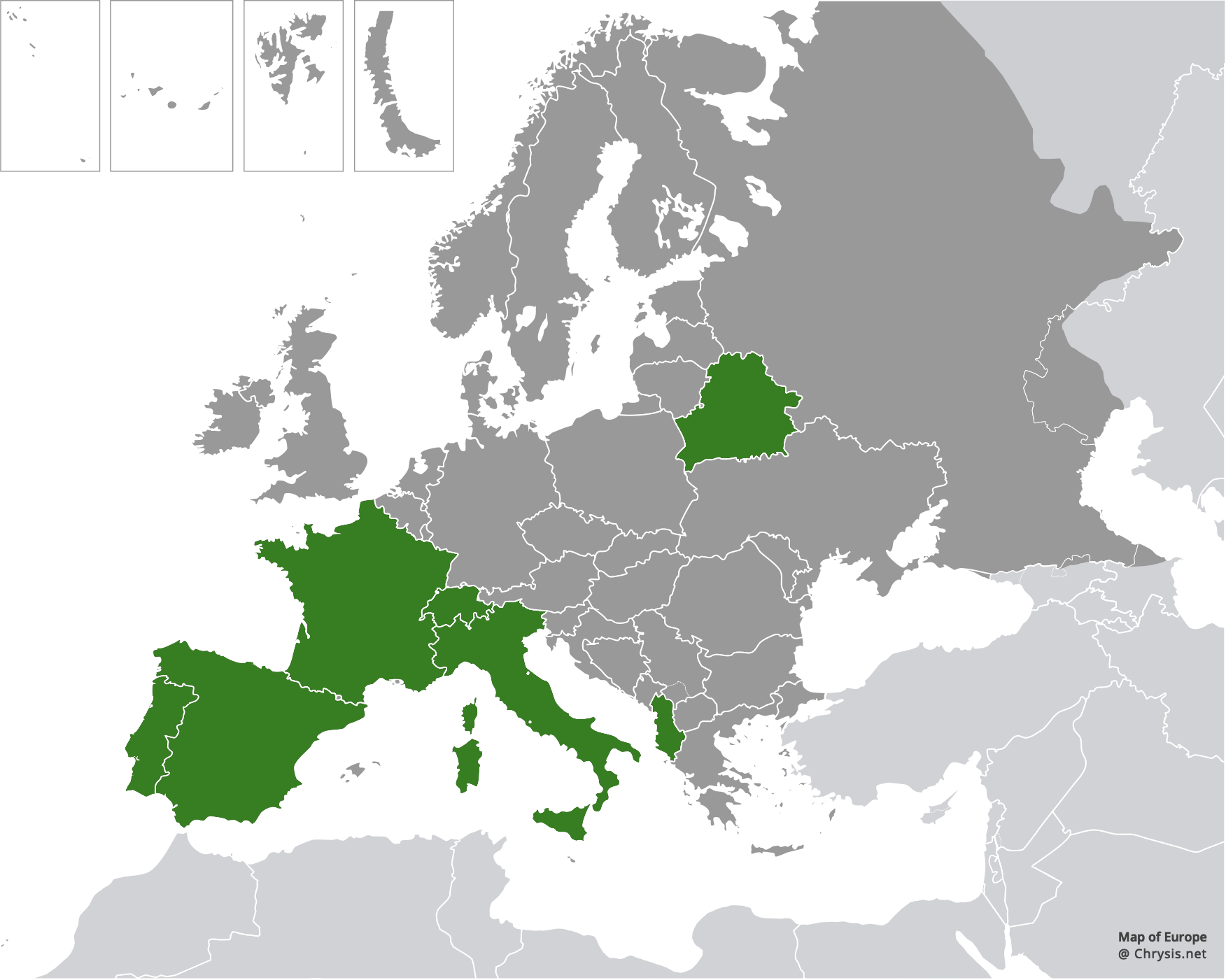
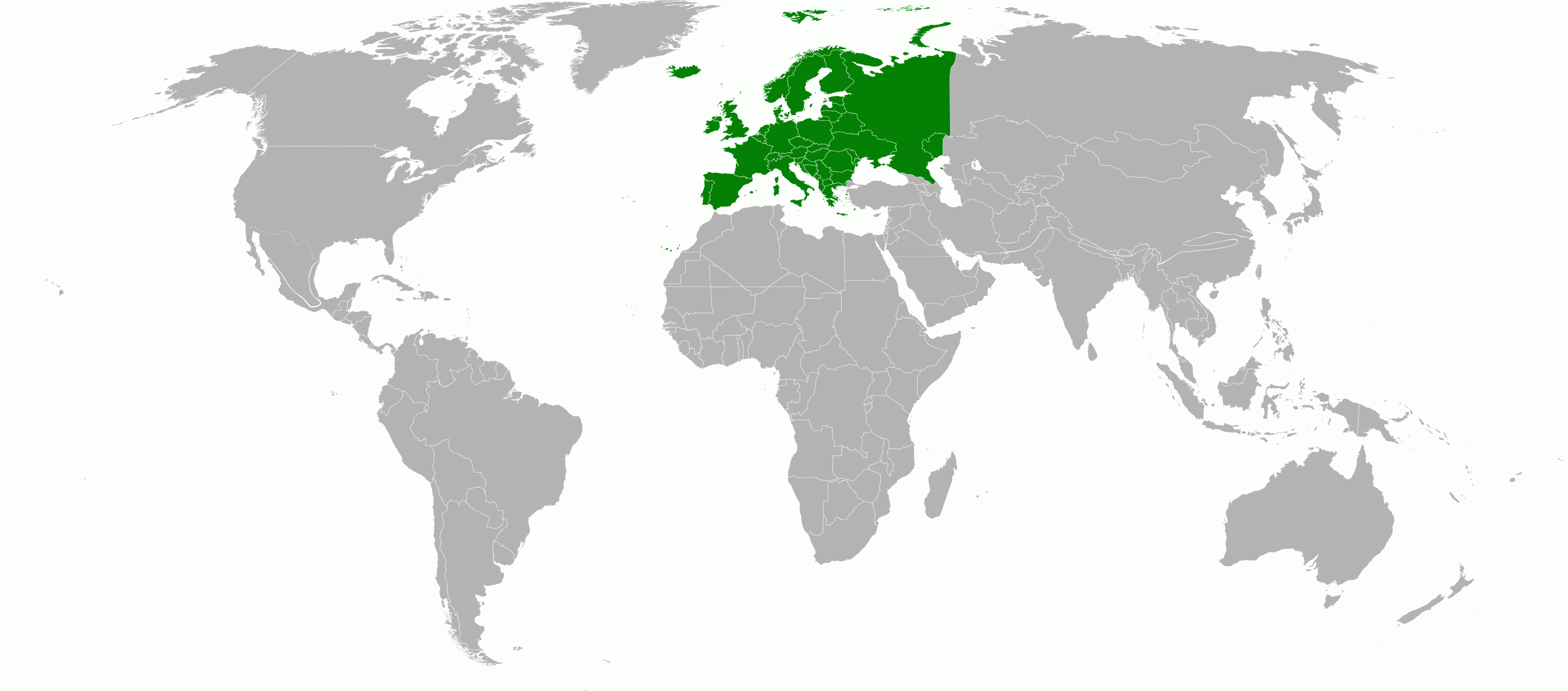
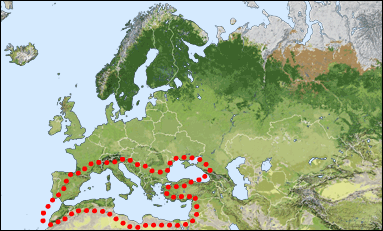
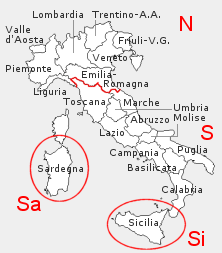 Here you find the presence/absence of the species in the different Administrative Regions of Italy (from North to South): Piemonte, Valle d'Aosta, Lombardia, Trentino A.A., Veneto, Friuli V.G., Liguria, Emilia Romagna, Toscana, Umbria, Marche, Lazio, Abruzzo, Molise, Campania, Puglia, Basilicata, Calabria, Sicilia, Sardegna, including the following smaller islands:
Here you find the presence/absence of the species in the different Administrative Regions of Italy (from North to South): Piemonte, Valle d'Aosta, Lombardia, Trentino A.A., Veneto, Friuli V.G., Liguria, Emilia Romagna, Toscana, Umbria, Marche, Lazio, Abruzzo, Molise, Campania, Puglia, Basilicata, Calabria, Sicilia, Sardegna, including the following smaller islands:
